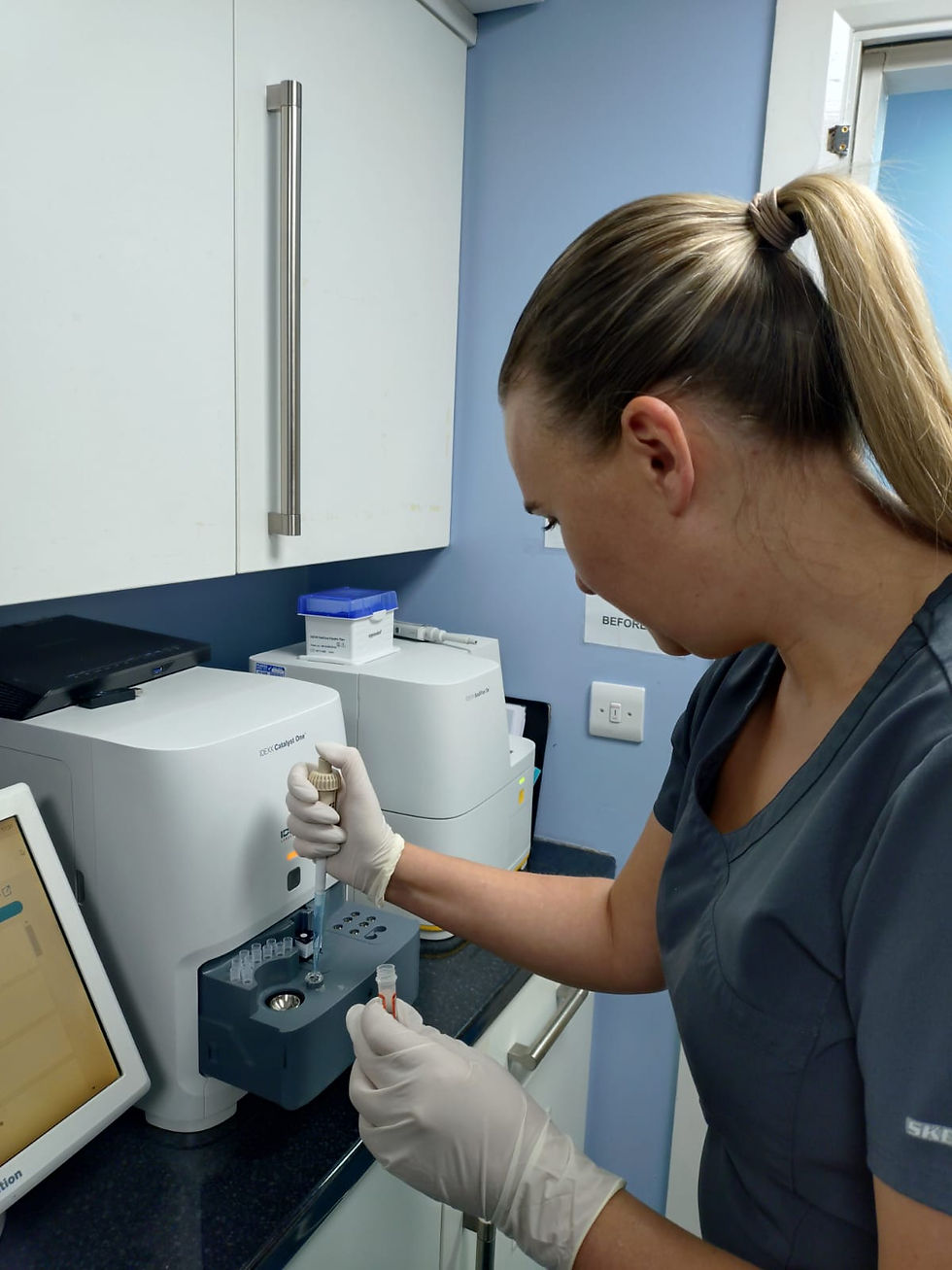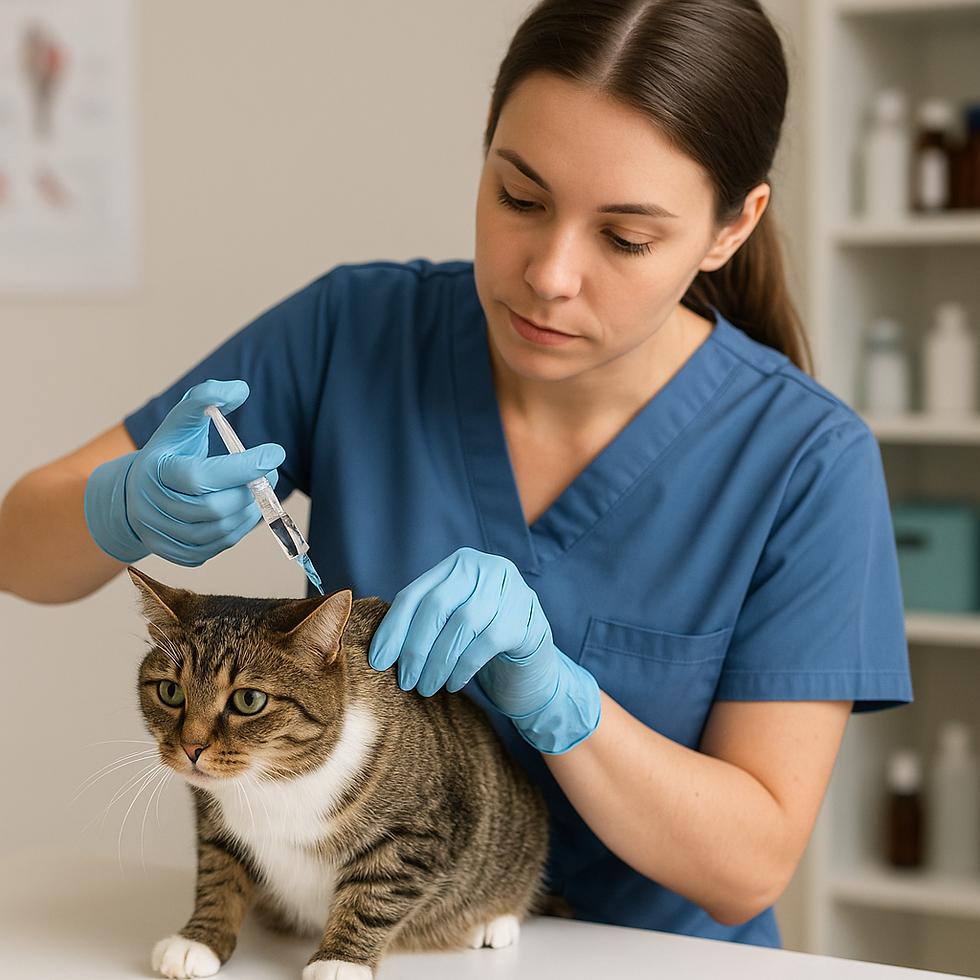Caring For Your Cat With Idiopathic Cystitis
- kellybainbridge7
- Jul 13, 2022
- 4 min read
We understand how difficult and stressful it can be to support a cat with a urinary condition. We hope to share advice on signs, diagnosis and management options for one of the most common urinary conditions seen in our cat-only clinic.

What is Feline Idiopathic Cystitis?
Many diseases can affect your cat’s lower urinary tract (their bladder and/or urethra) but one common condition can develop with no obvious underlying cause. Feline Idiopathic Cystitis (FIC) accounts for more than 60% of all cases of Feline lower urinary tract disease (FLUTD) and can be tricky to manage. FIC has been shown to be similar to the human condition, interstitial cystitis.
How will the vet diagnose FIC?
Diagnosis is usually via the exclusion of other recognise causes of FLUTD, as presently we do not have a reliable test. This means your cat will need a thorough work-up which may include urine samples being sent away for bacterial culture, X-rays and possibly ultrasound scans of the bladder.
Urine samples taken from cats with FIC can often show the presence of blood and inflammatory cells without an obvious cause, such as infection or stones forming in the bladder. Although crystals can contribute to inflammation they can also be found in cats without FIC as a side-effect of very concentrated urine.

What signs could I spot if my cat has FIC?
Most cats with FIC develop recurring episodes. An episode may last around a week, settle down only to flare up again later. In severe cases, the signs can recur with increased frequency and little rest bite, and in some cats, the signs may persist for longer periods. FIC can cause such severe bladder inflammation that it can be difficult to distinguish from an underlying tumour and biopsies may be advised to rule out other conditions.
Pain or difficulty passing urine (Dysuria)
Increased frequency of passing urine (Pollakiuria)
Blood in the urine (Haematuria)
Missing the litter tray when passing urine, or urinating elsewhere (Periuria)
Overgrooming around the genital area
Straining to urinate and producing very little or no urine. (Stranguria) Cats with FIc can often have muscle spasms or inflammation causing the urethra to block. Male cats have long narrow urethras and are more likely to become blocked. This is a medical emergency and requires immediate attention from your vet.

Abnormalities commonly found in cats with FIC
Although FIC is of unknown cause a number of shared abnormalities have been noted in cats with the condition.
Neurogenic inflammation - Local irritation to the bladder lining or messages via the brain as a response to stress can stimulate nerves in the bladder wall. This causes neurotransmitter chemicals to be released, which in turn increase local inflammation and pain.
Damaged bladder lining - Glycosaminoglycans (GAGs) compose a mucus layer lining the cells of the bladder. This helps protect the cells of the bladder wall. Urine contains a high amount of substances that could otherwise irritate these delicate cells. The GAG layers in many FIC cats appears to be lacking or defective, allowing damage to the underlying transitional cells and resulting in inflammation and ulceration.
Stress or abnormal stress responses - There is evidence of episodes of the disease being triggered by a stressful event, such as indoor multi-cat households where there may be a competition for resources (food, best sleeping area, access to the litter tray) There is also some agreement that these cats do not cope with stress in the ‘normal’ way. In healthy cats stress normally causes the release of adrenaline, noradrenaline and cortisol hormones by the adrenal glands. In cats with FIC, the cortisol response is not triggered in the same way.

Helping your cat live with FIC
Your vet will of course advise you on the most appropriate options for management on a case by case basis, which may include drugs and a prescription diet. The following can also go a long way to helping your cat.
Increasing water intake - changing to a wet diet and making sure there is always a good supply of fresh water, flavouring water with e.g. tuna or investing in a water fountain can all increase uptake. You can even mix a little tuna and water and freeze it in ice cube trays. Pop a couple of cubes in a bowl for a tasty treat. This aids in encouraging increased urination and also producing more dilute urine less likely to irritate the bladder lining. Provide multiple options to drink, quiet places and a variety of dishes as cats have a preference! Some dislike the aftertaste left by metal dishes and may prefer glass or ceramic. Keep bowls away from litter trays and ideally away from their food source. Some cats prefer large shallow bowls with plenty of room for their whiskers.
Litter trays - ideally one per cat and one spare in separate locations. Place them in quiet areas with low footfall and away from food and water bowls.
Reducing stress - Where stress triggers are known, do your best to minimise or avoid them. These are usually changes in the environment e.g. building work, strange people or pets in the home, changes to diet, overcrowding or owner related stress
Muti-cat households - conflict is the single most common cause of feline stress, carefully consider the sharing of resources (food, water, bed, trays) and the ability of your cat to avoid conflict with housemates.
Indoor only cats - Lack of enrichment can cause significant stress, compared to their free-roaming ancestors. Simple measures can be of huge benefit, set aside playtime each day with some of your cat’s favourite toys, and rotate toys to avoid boredom. Invest in a puzzle feeder or make your own treasure hunt. If possible offering access to an outdoor secure run, or in the garden on a harness (if tolerated) may be beneficial and stimulating. Modifications to the environment to accommodate scratch posts, hiding places and access to higher sleeping areas can help, but remember to be sensitive to any stress caused by a change to their home range.
Plug-ins - Feline pheromone plugins such as Feliway can help to reduce anxiety and stress.

Will my cat’s condition improve?
Taking steps to increase your cat’s water intake, reduce stress and boredom and improve their environment will significantly improve your cat’s quality of life. Some evidence suggests cats can improve as they mature although others remain difficult to manage.
We hope you have found this useful, remember our team is always on hand to talk through any concerns you may have relating to your cat’s health.






Comments